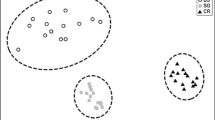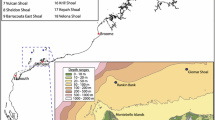Abstract
The relationship between densities of Achoerodus viridis (Pisces: Labridae) and reef habitats at various localities within New South Wales (NSW), Australia was examined. Types of habitats were quantified at inner, mid and outer estuarine locations in each of two estuaries (Botany Bay and Port Jackson) to determine whether purported patterns of movement from estuaries could be related to differences in habitat. Although the same types of habitat were generally found at all locations, differences in the proportion of habitat types were found between shallow and deep reefs and among inner, mid and outer estuarine locations for both estuaries. Shallow habitats were usually dominated by Ecklonia radiata, turf and/or fringe habitat in Botany Bay, whereas deep sites were generally dominated by urchin-grazed barrens habitat and, sometimes, sponge- and ascidian-dominated deep reef. Shallow sites in Port Jackson were dominated by a mixture of habitats, as were deep reefs at mid-estuarine locations. Other deep reefs in Port Jackson were dominated by E. radiata (inner estuarine) or barrens (outer estuarine) habitat. Thus, patterns of habitat cover were not consistent between estuaries and numbers of fish could not be related to proportional representation of habitat on reefs along estuarine gradients. Univariate and multivariate analyses showed that there was little evidence that any size class of fish was correlated with the proportional representation of a particular habitat or group of habitats. Counts of fish that focused on barrens and E. radiata forest habitats over a period of 10 yr showed that similar numbers and all sizes of fish were found in the two types of habitat. Greater numbers of small fish were, however, found in the E. radiata forest habitat than in the barrens habitat. Estimates of abundance along the coast of NSW (100s to 1000 km) in a range of habitats (e.g. ascidian-dominated reef, kelp forest, urchin-grazed barrens) showed that there was no indication that a particular habitat consistently had greater numbers of A. viridis than other habitats. Therefore, A. viridis of a range of sizes appears to be flexible in its use of habitats on reefs.
Similar content being viewed by others
Author information
Authors and Affiliations
Additional information
Received: 24 December 1997 / Accepted: 23 June 1998
Rights and permissions
About this article
Cite this article
Gillanders, B., Kingsford, M. Influence of habitat on abundance and size structure of a large temperate-reef fish, Achoerodus viridis (Pisces: Labridae). Marine Biology 132, 503–514 (1998). https://doi.org/10.1007/s002270050416
Issue Date:
DOI: https://doi.org/10.1007/s002270050416




